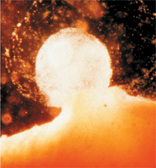▸ Ovulation As the follicle grows, it releases more and more estrogens. When concentrations of these hormones reach a certain level, the hypothalamus reacts by triggering a burst of LH and FSH from the anterior pituitary. The sudden increase in these hormones (especially LH) causes the follicle to rupture. The result is ovulation, the release of an egg from the ovary into one of the Fallopian tubes. When released, the egg is stalled in metaphase of meiosis II and will remain that way unless it is fertilized. As the newly released egg is drawn into the Fallopian tube, microscopic cilia push the cell through the fluid-filled tube, toward the uterus.

FIGURE 34–15 Ovulation (LM 160×)
▸ Luteal Phase The luteal phase begins immediately after ovulation. As the egg moves through the Fallopian tube, the cells of the ruptured follicle change. The follicle turns yellow and is now known as the corpus luteum (KAWR pus LOOT ee um), which means “yellow body” in Latin. The corpus luteum continues to release estrogens but also begins to release another steroid hormone called progesterone. Progesterone also stimulates the growth and development of the blood supply and surrounding tissue in the already-thickened uterine lining. The rise in these hormones once again inhibits the production of FSH and LH. Thus, additional follicles do not develop during this cycle.
Unless fertilization occurs and an embryo starts to develop, the fall of LH levels leads to the degeneration of the corpus luteum. Estrogen levels fall, the hypothalamus signals the release of FSH and LH from the anterior pituitary, and the follicular phase begins again.
▸ Menstruation At the start of the new follicular phase, low estrogen levels also cause the lining of the uterus to detach from the uterine wall. This tissue, along with blood and the unfertilized egg, are discharged through the vagina. This phase of the cycle is called menstruation. Menstruation lasts about three to seven days on average. A new cycle begins with the first day of menstruation.
MYSTERY CLUE

Low fat reserves in women have been associated with low FSH and LH levels. Tests showed that Lisa's blood had very low levels of these hormones. How might this have affected her menstrual cycle?
The menstrual cycle continues, on average, until a female is in her late forties to early fifties. At this time, the production of estrogens declines, and ovulation and menstruation stop. The permanent stopping of the menstrual cycle is called menopause.
BUILD Vocabulary
WORD ORIGINS The word menstruation comes from the Latin word mensis, meaning “month.”
Pregnancy Of course, the menstrual cycle also ceases if a woman becomes pregnant. During the first two days of the luteal phase, immediately following ovulation, the chances that an egg will be fertilized are the greatest. This is usually from 14 to 18 days after the completion of the last menstrual cycle. If a sperm fertilizes an egg, the fertilized egg completes meiosis and immediately undergoes mitosis. After several divisions, a ball of cells will form and implant itself in the lining of the uterus. Within a few days of implantation, the uterus and the growing embryo will release hormones that keep the corpus luteum functioning for several weeks. This allows the lining of the uterus to nourish and protect the developing embryo and prevents the menstrual cycle from starting again.
 In Your Notebook Draw a cycle diagram to represent the phases and days of the menstrual cycle.
In Your Notebook Draw a cycle diagram to represent the phases and days of the menstrual cycle.
Table of Contents
- Formulas and Equations
- Applying Formulas and Equations
- Mean, Median, and Mode
- Estimation
- Using Measurements in Calculations
- Effects of Measurement Errors
- Accuracy
- Precision
- Comparing Accuracy and Precision
- Significant Figures
- Calculating With Significant Figures
- Scientific Notation
- Calculating With Scientific Notation
- Dimensional Analysis
- Applying Dimensional Analysis




